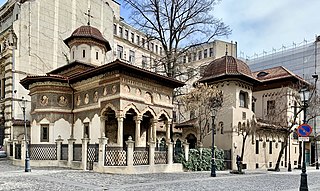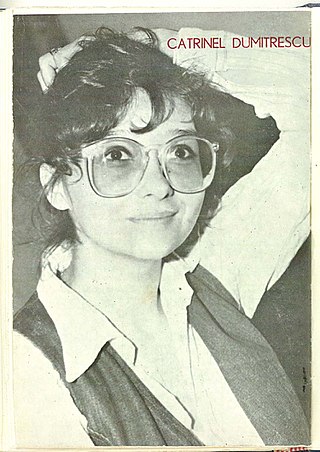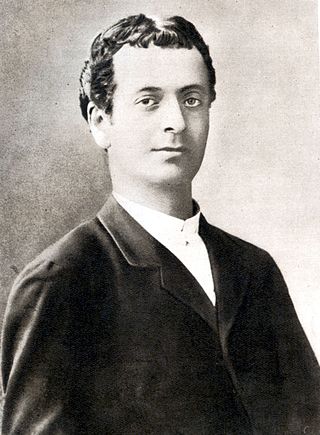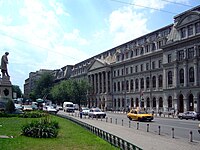
Luminița Gheorghiu was a Romanian film and stage actress and artistic performer in East Central Europe. She achieved international recognition for her roles in The Death of Mr. Lazarescu (2006) and Child's Pose (2013). Gheorghiu's roles were mostly in Romanian and French, including that in Code Unknown with Juliette Binoche.

Curtea Veche was built as a palace or residence during the rule of Vlad III Dracula in 1459. Archaeological excavations started in 1953, and now the site is operated by the Muzeul Municipiului București in the historic centre of Bucharest, Romania.

Stavropoleos Monastery, also known as Stavropoleos Church during the last century when the monastery was dissolved, is an Eastern Orthodox monastery for nuns in central Bucharest, Romania. Its church is built in Brâncovenesc style. The patrons of the church are St. Archangels Michael and Gabriel. The name Stavropoleos is the genitive case of Stavropolis. One of the monastery's constant interests is Byzantine music, expressed through its choir and the largest collection of Byzantine music books in Romania.

The I. L. Caragiale National University of Theatre and Film is a public university in Bucharest, Romania, founded in 1954. It is named in honour of playwright Ion Luca Caragiale.

The Dormition of the Theotokos Cathedral is a Romanian Orthodox religious building in Satu Mare, Romania. Located on Dr. Vasile Lucaciu boulevard, it was originally built from the plans of the Romanian architect Gheorghe Liteanu, who was inspired by the Curtea de Argeș Cathedral. The cathedral has a length of 34.5 metres (113 ft), a width of 24.5 metres (80 ft), and a height of 55 metres (180 ft). As the seat of an archpriest and not a bishop, it is a church and not technically a cathedral, but is commonly referred to as such.

Dimitrie Maimarolu was a Romanian architect, whose designs featured French Beaux-Arts style.
Florin Zamfirescu is a Romanian theatre and film actor and director, and university professor.

Saint Basil the Great Cathedral, located at 50 Polonă street, is the first Romanian Greek-Catholic church built in Bucharest. The church's patron is Basil of Caesarea and its dedication celebration is on January 1.
Nicolae Ghica-Budești was an influential Romanian architect who helped define the Neo-Romanian style. He studied ancient monuments in Wallachia, writing four volumes documenting the architectural history of the region. The "Muntenia and Oltenia evolution in architecture" was based on his work. His masterpiece is the Museum of the Romanian Peasant which took more than two decades to complete.

Haralamb George Lecca, also known as Haralamb Leca, Har. Lecca, or Haralambie Lecca, was a Romanian poet, playwright and translator. He belonged to an upper-class family, being the grandson of artist Constantin Lecca and brother of genealogist Octav-George Lecca, as well as nephew and rival of writer Ion Luca Caragiale. He had an unsettled youth, studying medicine and law for a while, and also reaching a Sub-Officer's rank in the terrestrial army. He debuted in literature under the guidance of Bogdan Petriceicu Hasdeu, who also employed Lecca's services as a medium. His early work was in poetry, often outstandingly macabre, evidencing his familiarity with 19th-century French literature and hinting at a vague affiliation with Symbolism. Briefly a collaborator of Junimea society, then of its dissident wings, Lecca never joined the fledgling Symbolist movement, and spent his later life in relative isolation from all literary circles.
Alexandru Dabija is a stage director and actor in Romanian theater and film.
Ana-Maria Bamberger is a playwright of Romanian origin working in French, English, German, and Romanian.

Romanian Revival architecture is an architectural style that has appeared in the late 19th century in Romanian Art Nouveau, initially being the result of the attempts of finding a specific Romanian architectural style. The attempts are mainly due to the architects Ion Mincu (1852–1912), and Ion N. Socolescu (1856–1924). The peak of the style was the interwar period. The style was a national reaction after the domination of French-inspired Classicist Eclecticism. Apart from foreign influences, the contribution of Romanian architects, who reinvented the tradition, creating, at the same time, an original style, is manifesting more and more strongly. Ion Mincu and his successors, Grigore Cerchez, Cristofi Cerchez, Petre Antonescu, or Nicolae Ghica-Budești declared themselves for a modern architecture, with Romanian specific, based on theses such as those formulated by Alexandru Odobescu around 1870:
"Study the remains – no matter how small – of the artistic production of the past and make them the source of a great art (...) do not miss any opportunity to use the artistic elements presented by the Romanian monuments left over from old times; but transform them, change them, develop them ..."

Catrinel Dumitrescu is a Romanian film and theater actress.

St. Stephen–Călărași Church is a Romanian Orthodox church located at 83 Calea Călărași in Bucharest, Romania. It is dedicated to Saint Stephen.
Monalisa Basarab is a Romanian theater and film actress.

Constantin I. Nottara was a Romanian stage actor and director.

St. Sylvester's Church is a Romanian Orthodox church located at 36 Silvestru Street in the Moșilor quarter of Bucharest, Romania. It is dedicated to the Dormition of the Mother of God and to Saint Pope Sylvester I.

The St. Elijah–Colței Inn Church is a Romanian Orthodox church located at 18 Doamnei Street in the Lipscani quarter of Bucharest, Romania. It is dedicated to the Prophet Elijah.

The Princely Church of Saint Nicholas in Curtea de Argeș was founded by Basarab I, completed in 1352, in the perimeter of the 13th century voievodal court. The church, a complex inscribed Greek cross monument, is one of the most representative monuments of medieval Romanian architecture, being the oldest voivode funded religious monument in Wallachia. The interior murals are from 1364 - 1369. The church is included on the new list of Romanian historical monuments: AG-II-m-A-13647.01 and in the UNESCO Indicative List.























